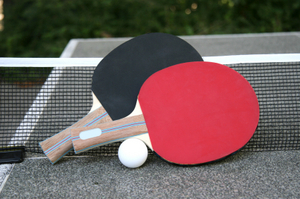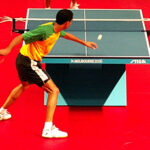Tennis tables are divided into two groups: indoor tables and outdoor tables. When looking to purchase a table, many of the criteria apply to both types. This article will deal mostly with indoor tables. Whether you are looking to play competitively or just want to have some fun with friends and family, choosing the right table is important. I’ll assume that anyone reading this is either a first-timer or recreational player.
Since tables can range in price from $150 for a basic fold-up model to over $2000 for professional international competition models, its very important to know what you want it for prior to purchasing. It’s easy for shoppers to get caught up into buying more table than they really need. Like any other purchase know what you want it for and have a reasonable budget in mind.
Unless you’ve already played for a few years, I recommend purchasing a lower-end model to develop your skills on. By the time you’ve worn it out, your skills will have improved enough to warrant buying a better model with features a more experienced player will appreciate. Beginners should look for a lightweight model with wheels and can fold up easily.
The playing surface of a table can range in thickness from around 15mm up to 25mm. Serious competitors and experienced players should opt for the thicker models because those are used in tournaments. Beginners and recreational players will find that the less expensive 19mm tables will perform just fine. The thicker the tabletop, the better it is at resisting warping. Thicker tops also make for better play because they provide a more consistent bounce. Most tabletops are made of simple particleboard, especially at the lower end of the market. As you move up in price, you may see more tables made of other materials with better warp-resistance. Kneel down to the level of the tabletop and check it out from every angle. You’re looking for any signs of warping, which will ruin any game played on the table. If you’re really serious about this, you can even bring a level to check it out. Keep in mind that the price difference between thicknesses can be several hundred dollars.
Another thing to look at regarding the tabletop is its finish. You want one with a smooth, even finish. Reject any tables with rough spots or patched areas. A standard 40mm table tennis ball should bounce around 23cm when dropped from about 30mm. You should be able to get a correct bounce from any spot on the table. If you can’t get a uniform bounce, don’t buy the table.
A second important feature of tables is the legs. Since the legs support everything, it’s vital to have strong and sturdy ones. The standard height of a table is 76cm, so look for a table with leg levelers. These are important if you have uneven floors or you expect your table to see some rough use. Better support equates to more even support, which is a factor of good ball bounce. Look for tables with large legs or ones with many legs and many connecting points to ensure good stability. Most mass marketers don’t sell very sturdy tables; so if you really want a good table, see a retailer that specializes in table tennis tables.
The net is another aspect of the table to pay attention to. Table tennis rules state that the top of the net must be a uniform 15.25 cm high, with the bottom and sides of the net as close as possible to the tabletop and support posts. You want a net that doesn’t sag and seems to be in good repair. Also, some net attachments can mar the playing surface, so look for a net with attachments that have a nice, soft covering.
A regulation-sized table measures 9 feet long, 5 feet wide and stands 30 inches off the ground. This is important because there are a few different sizes of table available. Unless you are really pressed for space or are looking for something unusual, I recommend staying away from anything that isn’t official-sized. Playing on any other surface will result in the forming of poor habits. There are also a number of companies that sell table tennis conversion tops. Basically these are table tennis surfaces that are placed on top of another gaming table, like a pool table. These usually don’t work out so well because the sizes of the tabletops don’t match well and the playing surface is normally too high up.
As I mentioned earlier, outdoor tables are also available. If you do decide to play outdoors, don’t roll your indoor table out into the yard. Buy a table created for outdoor play. They cost more than indoor tables, but they’re built to resist the elements a little more. They also weigh quite a bit more, often coming in at a hefty 100-350 pounds. In my opinion, table tennis is a game of finesse and skill, playing it outdoors introduces too many variables that can have an adverse effect on the game. Buy a good indoor table and keep your game indoors.
Once you decide to go out and purchase a table, you’ll discover there are a lot of different ones to choose from. Take your time and talk to the experts. Find one that fits your needs and you’ll enjoy the game that much more.



